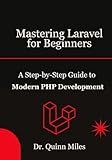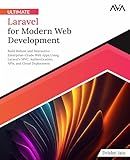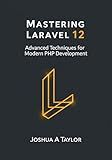Best Laravel Development Books to Buy in December 2025

Laravel: Up & Running: A Framework for Building Modern PHP Apps



Laravel: Up & Running: A Framework for Building Modern PHP Apps



Mastering Laravel for Beginners: A Step-by-Step Guide to Modern PHP Development



Ultimate Laravel for Modern Web Development: Build Robust and Interactive Enterprise-Grade Web Apps using Laravel's MVC, Authentication, APIs, and ... (Advanced Web Frameworks — Multi-Tech Path)



Practical Laravel: Develop clean MVC web applications



Mastering Laravel 12 : Advanced Techniques for Modern PHP Development


In Laravel, joining two models is accomplished using Eloquent relationships. Eloquent is Laravel's built-in ORM (Object-Relational Mapping) system which enables you to interact with your database records using models instead of writing raw SQL queries.
To join two models in Laravel, you need to define a relationship between them. There are several types of relationships available in Laravel, including one-to-one, one-to-many, many-to-many, and polymorphic relationships.
Here's an example of how to join two models using a one-to-many relationship:
-
Define Models: First, create two models, let's say "User" and "Post", using the php artisan make:model command. In the User model, define a relationship with the Post model by adding the following method: public function posts() { return $this->hasMany(Post::class); } In the Post model, define the inverse relationship with User by adding the following method: public function user() { return $this->belongsTo(User::class); }
-
Fetching Joined Data: To fetch the joined data, you can use eager loading. Eager loading helps to reduce the number of individual database queries by retrieving all related records upfront. Suppose you want to fetch all posts with their respective user information. You can use the with() method in your controller: $posts = Post::with('user')->get(); This will load all posts and their corresponding user information in a single query, improving performance.
-
Accessing Joined Data: Once you have fetched the joined data, you can access it within your views or controllers. For example, in your view, you can iterate through the posts and access the user information like this: @foreach($posts as $post)
{{ $post->user->name }}
{{ $post->title }}
@endforeach Here, $post->user represents the user model related to the post, and $post->user->name gives you the name of the user who created the post.
Remember to adjust the model and relationship names according to your application's specific logic. Laravel provides various other helpful methods and relationship types, enabling you to create more complex joins and queries between models.
How to filter joined models based on certain conditions in Laravel?
In Laravel, you can filter joined models based on certain conditions using query constraints. Here are the steps to do this:
- Define relationships between models: Make sure you have defined the appropriate relationships between your models using Eloquent's relationship methods like hasOne, belongsTo, hasMany, etc.
- Use join method to join the tables: In your query, use the join method to join the related tables. You can specify the relationship as the first argument, and the condition for the join as the second argument. $query = Model1::join('model2', 'model1.foreign_key', '=', 'model2.local_key');
- Add constraints to the join: Use the where method or other query constraints to add additional conditions to the join. These constraints will be based on the attributes of the joined models. $query->where('model2.column', '=', 'value');
- Retrieve the results: Finally, retrieve the filtered results using methods like get, first, or paginate. $results = $query->get();
Here is an example that demonstrates these steps in context:
$posts = Post::join('users', 'posts.user_id', '=', 'users.id') ->where('users.active', true) ->get();
In this example, it joins the users table with the posts table, and filters the joined models based on the condition where users.active is true. The resulting posts will only be those associated with active users.
How to load only specific relationships when joining models in Laravel?
In Laravel, you can specify the relationships to be loaded when joining models using the with() method. This helps to optimize the query by loading only the required relationships and avoiding unnecessary data retrieval.
Here's an example of how you can load specific relationships when joining models in Laravel:
$users = User::with('posts.comments', 'profile')->get();
In this example, we are loading the posts relationship with its nested comments relationship, as well as the profile relationship for each user. This will result in two database queries: one to retrieve the users and their profiles, and another to retrieve the posts and their comments.
You can also load multiple relationships using an array:
$users = User::with(['posts', 'profile'])->get();
If you want to load specific relationships for a single model instance, you can use the load() method:
$user = User::find(1); $user->load('posts');
This will load the posts relationship for the user with ID 1.
By selectively loading only the necessary relationships, you can improve the performance of your application by reducing the number of database queries executed.
How to retrieve related models when joining in Laravel?
When you want to retrieve related models while performing a join in Laravel, you can use the with() method or eager loading.
Here's an example of how you can retrieve related models when using a join in Laravel:
$users = DB::table('users') ->join('posts', 'users.id', '=', 'posts.user_id') ->join('comments', 'posts.id', '=', 'comments.post_id') ->select('users.*', 'posts.title', 'comments.body') ->with(['posts', 'comments']) ->get();
In the above example, we are joining the 'users', 'posts', and 'comments' tables. We are selecting specific columns from each table and also eager loading the 'posts' and 'comments' relationships.
Then, you can access the related models on each user object like this:
foreach ($users as $user) { echo $user->name;
foreach ($user->posts as $post) {
echo $post->title;
}
foreach ($user->comments as $comment) {
echo $comment->body;
}
}
By using the with() method or eager loading, Laravel will fetch the related models in a more efficient way by using eager loading, reducing the number of queries executed.
